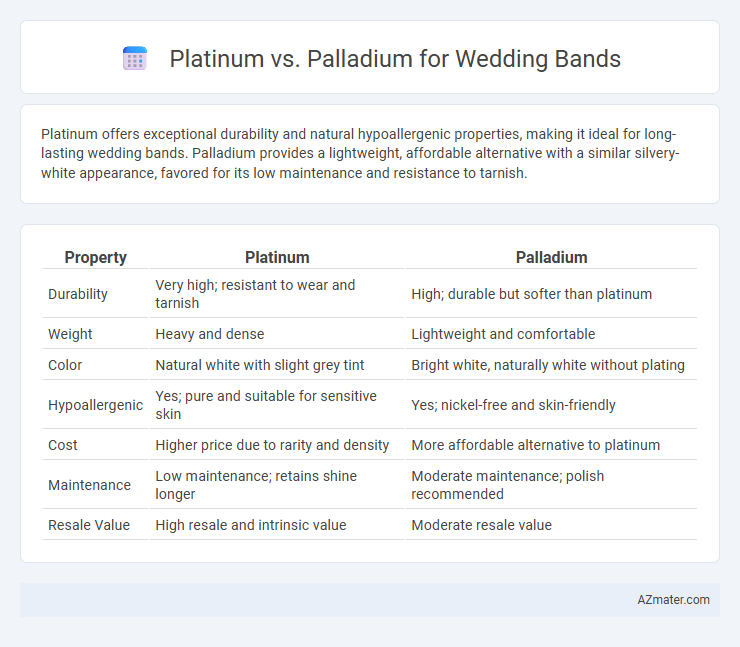Platinum offers exceptional durability and natural hypoallergenic properties, making it ideal for long-lasting wedding bands. Palladium provides a lightweight, affordable alternative with a similar silvery-white appearance, favored for its low maintenance and resistance to tarnish.
Table of Comparison
| Property | Platinum | Palladium |
|---|---|---|
| Durability | Very high; resistant to wear and tarnish | High; durable but softer than platinum |
| Weight | Heavy and dense | Lightweight and comfortable |
| Color | Natural white with slight grey tint | Bright white, naturally white without plating |
| Hypoallergenic | Yes; pure and suitable for sensitive skin | Yes; nickel-free and skin-friendly |
| Cost | Higher price due to rarity and density | More affordable alternative to platinum |
| Maintenance | Low maintenance; retains shine longer | Moderate maintenance; polish recommended |
| Resale Value | High resale and intrinsic value | Moderate resale value |
Introduction: Platinum vs Palladium for Wedding Bands
Platinum and palladium are premium metals valued for their durability and natural white luster, making them popular choices for wedding bands. Platinum is denser and heavier, offering exceptional strength and hypoallergenic properties, while palladium is lighter and more affordable with a similar silvery-white finish. Both metals resist tarnish and maintain their shine over time, ensuring lasting elegance for wedding bands.
Metal Composition and Properties
Platinum is a dense, naturally white metal composed of 95% pure platinum, known for its exceptional durability and hypoallergenic properties, making it ideal for long-lasting wedding bands. Palladium, part of the platinum group metals with a slightly lighter density, is typically used in 90-95% purity for jewelry and offers a bright white finish that resists tarnish and scratches. Both metals maintain their luster over time, but platinum's higher density results in a heavier, more substantial ring, while palladium provides a lighter, more affordable alternative without sacrificing strength or durability.
Color and Appearance Comparison
Platinum exhibits a naturally white, lustrous sheen that remains untarnished over time, maintaining its bright, silvery appearance without the need for plating. Palladium shares a similar white hue but is slightly grayer and less reflective, giving it a more muted elegance compared to platinum's vivid shine. Both metals develop a subtle patina with wear, but platinum's denser composition ensures a heavier, more substantial feel often preferred for luxury wedding bands.
Durability and Scratch Resistance
Platinum wedding bands offer exceptional durability due to their dense and malleable nature, making them highly resistant to wear and tear over time. Palladium, while also durable, is lighter and tends to scratch more easily compared to platinum, requiring more frequent polishing to maintain its appearance. Both metals are hypoallergenic, but platinum's superior scratch resistance makes it a preferred choice for long-lasting wedding bands.
Weight and Comfort on the Finger
Platinum wedding bands are notably denser, weighing approximately 21.45 grams per cubic centimeter, which gives them a substantial, luxurious feel on the finger but may feel heavier during prolonged wear. Palladium, with a density of around 12.02 grams per cubic centimeter, offers a lightweight alternative that enhances comfort without compromising durability or appearance. Couples seeking a balance between elegance and ease often prefer palladium for its lighter weight and hypoallergenic properties, providing all-day comfort.
Hypoallergenic Qualities
Platinum is highly valued for its hypoallergenic properties, making it an excellent choice for wedding bands worn by individuals with sensitive skin or metal allergies. Palladium also offers hypoallergenic benefits but is less dense and heavier than platinum, which may affect comfort and durability. Both metals resist tarnishing and corrosion, but platinum's natural purity often results in fewer allergic reactions over time.
Maintenance and Care Requirements
Platinum wedding bands require minimal maintenance due to their durability and natural resistance to tarnish, making them ideal for daily wear without frequent polishing. Palladium, while also resistant to tarnish, is lighter and may scratch more easily, necessitating occasional polishing to maintain its shine. Both metals benefit from regular cleaning with mild soap and water, but platinum's density ensures long-lasting appearance with less intensive care compared to palladium.
Price Differences and Value
Platinum wedding bands typically cost 30-50% more than palladium due to their higher density and rarity, offering exceptional durability and hypoallergenic properties. Palladium provides a more affordable alternative with a similar white metal appearance but lower weight and slightly less scratch resistance. Choosing between platinum and palladium depends on balancing long-term value, with platinum retaining more intrinsic worth and prestige over time.
Popular Styles and Design Options
Platinum wedding bands are prized for their durability and naturally white sheen, often showcasing intricate milgrain detailing or classic solitaire settings that accentuate diamond brilliance. Palladium rings, lighter and more affordable, frequently feature modern designs such as hammered finishes or brushed textures, appealing to those seeking a contemporary aesthetic. Both metals offer hypoallergenic properties, making them ideal choices for couples prioritizing comfort alongside style in their wedding band selection.
Which Metal Is Best for Your Wedding Band?
Platinum and palladium are both durable, hypoallergenic metals ideal for wedding bands, but platinum offers superior density and natural white luster that resists tarnish over time. Palladium, lighter and more affordable, provides similar strength and a white finish without the need for rhodium plating, appealing to those seeking comfort and low maintenance. Choosing between these metals depends on personal preferences for weight, budget, and long-term appearance in your wedding band.

Infographic: Platinum vs Palladium for Wedding Band
 azmater.com
azmater.com